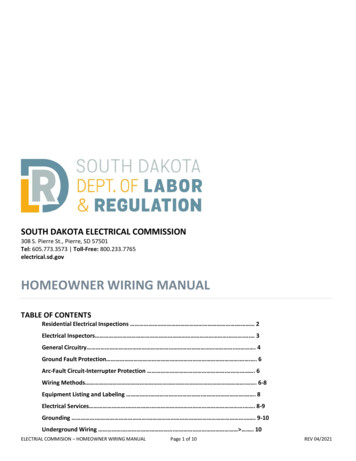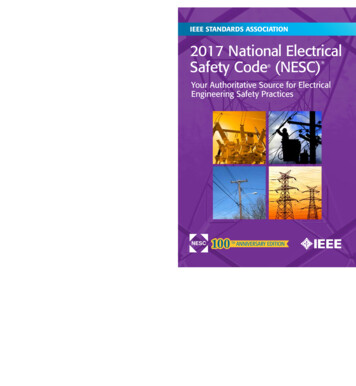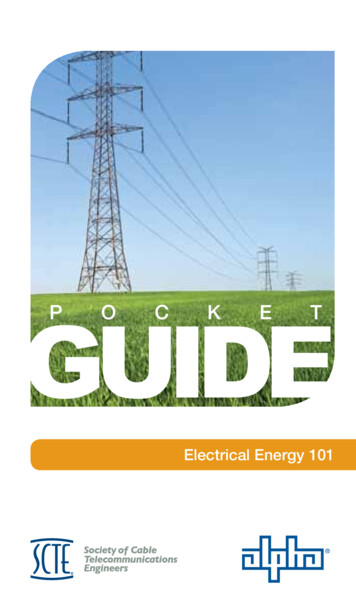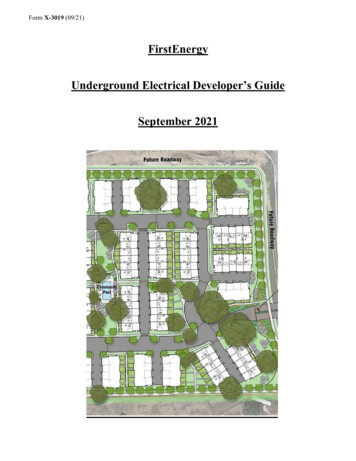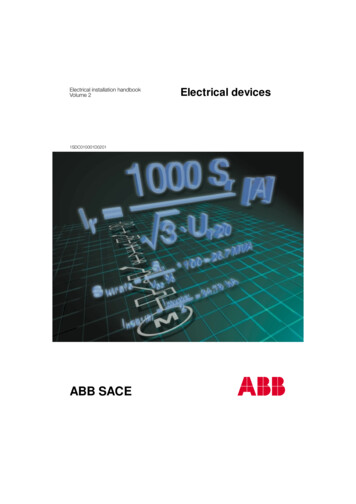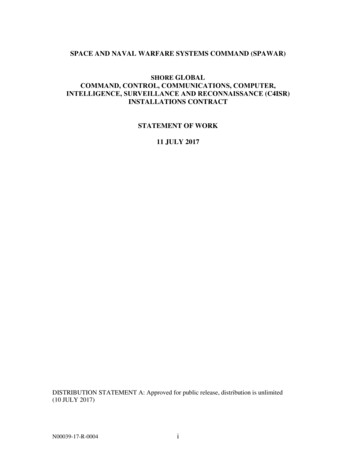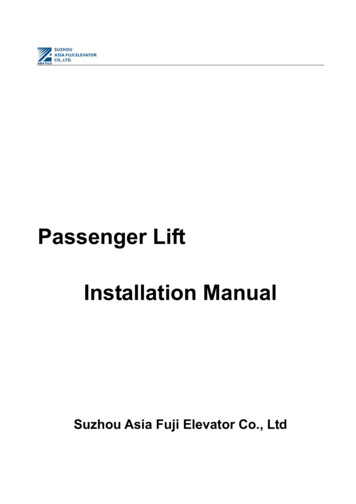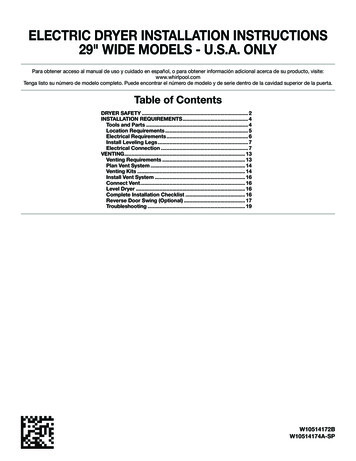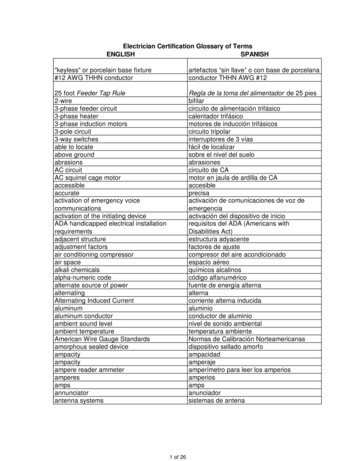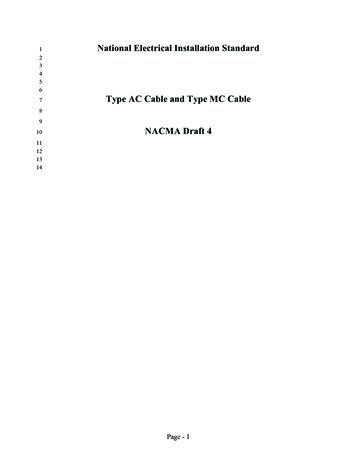
Transcription
1234567National Electrical Installation StandardType AC Cable and Type MC Cable8910NACMA Draft 411121314Page - 1
031323334353637383940414243444546Table of Contents1.1.1SCOPERegulatory and Other Requirements2.Glossary3.3.1IDENTIFICATION OF CABLESIdentification4.4.14.24.34.3.14.44.5ARMORED CABLE (TYPE AC)DescriptionEquipment GroundingUses Permitted, GeneralUses Permitted, Special OccupanciesUses Not .75.7.15.7.25.7.35.7.45.7.5METAL-CLAD CABLES (TYPE MC)DescriptionConductorsSpecial MC Cable ConfigurationsEquipment GroundingInterlocking Metal Tape SheathSmooth or Corrugated SheathUses PermittedUses Not PermittedConnectorsCriterion for selectingIdentification of connectorSize of ConnectorSuitable for type of cable or locationGrounding.6.GENERAL INSTALLATION PROCEDURES6.1General Installation Procedures for Type AC and MC Cables6.2Installation of Home Runs6.2.1 Planning6.2.2 Home Run Cables6.2.3 Phasing of Circuit Conductors6.2.4 Application of Adjustment Factors6.2.4.1 When the Neutral Counts as Current-Carrying6.3Cutting AC and MC Cables6.3.1 Rotary Armor Cutter6.3.2 Hacksaw6.3.3 Wire CuttersDraft 4Page - 2
0316.3.46.46.56.5.16.5.26.66.7CautionPosition of Cable in ConnectorOvercurrent Protection and DeratingType AC CablesType MC CablesFishing CablesInstalling Cables Through Fire-Rated Walls, Floors or Ceilings7.7.17.27.37.3.1AC CABLES -- SPECIFIC INSTALLATION PROCEDURESBoxes and FittingsIsolated Equipment GroundingHealth Care FacilitiesEmergency Systems in Health Care Facilities8.MC CABLES -- SPECIFIC INSTALLATION PROCEDURES8.1Boxes and Fittings8.2Isolated equipment grounding8.3Health care facilities8.3.1 Emergency Systems in Health Care Facilities8.4Terminating Type MC Cable Containing Bare Aluminum Bonding/GroundingConductor9.TYPE MC CABLES IN HAZARDOUS (CLASSIFIED) LOCATIONS9.1Class I Locations9.2Class II Locations9.3Seals in Hazardous (Classified) LocationsTable 9.1 – Hazardous (Classified) LocationsAnnex: Reference StandardsDraft 4Page - 3
031323334353637383940414243444546474849(This foreword is not part of the standard)ForewordNational Electrical Installation Standards are designed to improvecommunication among specifiers, purchasers, and suppliers of electricalconstruction services. They define a minimum baseline of quality andworkmanship for installing electrical products and systems. NEIS are intendedto be referenced in contract documents for electrical construction projects. Thefollowing language is recommended:Type AC and MC cables shall be installed in accordance withNECA/NACMA 120, Standard for Installing Type AC Cable and TypeMC Cable (ANSI).Use of NEISTM is voluntary, and the neither the National Electrical ContractorsAssociation nor the National Armored Cable Manufacturers Association assumeany obligation or liability to users of this publication. Existence of a standardshall not preclude any member or non-member of either organization fromspecifying or using alternate construction methods permitted by applicableregulations.At the time of publication of this standard, it is intended the standard complieswith the most recent edition of the National Electrical Code (NEC). Becausethey are quality standards, NEIS may in some instances go beyond the minimumsafety requirements of the NEC. It is the responsibility of users of thispublication to comply with state and local electrical codes when installingelectrical products and systems.Suggestions for revisions and improvements to this standard are welcome. Theyshould be addressed to:NECA Codes and Standards3 Bethesda Metro Center Suite 1100Bethesda, MD 20814(301) 215-4521(301) 215-4500 Faxwww.neca-neis.orgneis@necanet.orgTo purchase National Electrical Installation StandardsTM, contact the NECA Order Desk at (301)215-4504 tel, (301) 215-4500 fax, or orderdesk@necanet.org. NEIS are also available in .PDFdownload format at www.neca-neis.org/catalog .Copyright 2005, National Electrical Contractors Association. All rights reserved.Unauthorized reproduction prohibited.National Electrical Installation Standards and NEIS are registered trademarks of the NationalElectrical Contractors Association. National Electrical Code and NEC are registered trademarksof the National Fire Protection Association, Quincy, Massachusetts.Draft 4Page - 4
0311.SCOPEThis standard covers the installation of Type AC and Type MC cables, which are used forelectrical wiring for residential, commercial and industrial occupancies. It also includesinformation on fittings and other accessories necessary for a quality installation of thesecable systems.This standard is intended to enhance electrical safety by:1.2.3.4.1.1Ensuring that the proper cable is selected for the installation.Describing proper installation methods for Type AC and MC cables.Aiding installers in meeting the “neat and workman like” requirements of theNEC.Creating an installation that will protect the wire conductors from mechanicalabuse.Regulatory and Other RequirementsAll information in this publication is intended to comply with the National ElectricalCode (NFPA 70). Installers should always follow the NEC, applicable state and localcodes, and manufacturers’ instructions when installing electrical products and systems.Only qualified persons as defined in the NEC who are familiar with Type AC and MCcables should perform the work described in this publication.Other National Electrical Installations Standards provide guidance for installingadditional types of electrical products and systems. A complete list of NEIS is providedin Annex A.Draft 4Page - 5
aryFire-stopping. Using approved materials (generally detailed by building codes orspecifications) which fill the opening around the cable(s) to prevent the spread of fire andsmoke and to assure the fire rating of the wall, floor, or ceiling being penetrated is notreduced.Fire-rated assemblies. Construction materials assembled together, then tested and ratedfor their ability to inhibit the spread of fire for a specified period of time under specifictest conditions. The rating is expressed in hours, e.g. 1 hour, 2 hour, etc. Information canbe found in various product testing laboratory listing directories.Fishing. The installation of cable in closed or partially closed construction by pushing orpulling it from one point of access to another.Home run. The installation of cable(s), conduit(s) or tubing(s) between the panelboardand the first distribution point such as a junction or pull box where branch circuit cablesoriginate.Through-Penetration Fire Stop System. A listed assemblage of specific materials orproducts that are designed, tested and fire-resistance rated in accordance with ASTME814 to resist, for a prescribed period of time, the spread of fire through penetrations infire-rated assemblies.Draft 4Page - 6
123456789103.IDENTIFICATION OF CABLES3.1IdentificationType MC cable of the interlocked-armor type and Type AC cable may look similar ontheir exterior. It is important that the proper cable be selected for installations wherespecific construction features or performance requirements are desired or are required inthe NEC. Specific uses permitted and not permitted are identified in the followingsections of this standard. Consult the following table for assistance in identifying cables.Type AC CableInterlocked ArmorType MC CableInterlocked ArmorType MC Cablewith Armor/Bond(MCI-A)1Number of Conductors Limited to no morethan 4 conductorsplus an equipmentgrounding conductor.Size of Conductors14 AWG to 1 AWGEquipment GroundingPathContains a 16 AWGbond wire in constantcontact with themetal armor. Thebond wire and armortogether are used asan equipmentgrounding conductor.Cable ConstructionIndividualthermoplasticinsulated conductorsare wrapped in amoisture resistant,fire retardant paper.Individualconductors withthermoset insulationdo not require a paperwrap, the wrap mustbe applied to theNo limit on numberof conductors.No limit on numberof conductors.18 AWG – 2000kcmilNo bonding wire. Thearmor is not itself anequipment ground.The internalequipment groundingconductor incombination with thearmor is theequipment ground.14 AWG –6 AWGA protective coveringover the individualinsulated or jacketedconductors may beprovided or theconductor assemblymay have an overallnonmetallic wrapunder the armor1Contains a full sizealuminumgrounding/bondingconductor inconstant contactwith the metalarmor. The bondwire and armortogether are used asan equipmentgroundingconductor.A protectivecovering over theindividual insulatedor jacketedconductors may beprovided or theconductor assemblymay have an overallnonmetallic wrapunder the armorThe abbreviation (MCI-A) is used for the sake of brevity and is not specifically noted in the NEC nor UL1569.Draft 4Page - 7
entire assembly.1Type ACCableType MCCable23456Photo No. 1. AC and MC cableDraft 4Page - 8
031323334354.ARMORED CABLE (TYPE AC)4.1DescriptionType AC cable is a factory assembly of insulated conductors protected in an overallflexible interlocked metallic armor (sheath). The metallic sheath may be of aluminum orsteel material. Armored cable having an aluminum sheath is suitable for use inalternating current circuits only.Type AC cable is permitted to have from two to four conductors in sizes 14 through 1AWG copper with or without an equipment grounding conductor. All conductors withthermoplastic insulation have an individual moisture-resistant fiber wrap and are cabledtogether in the manufacturing process.Typical branch circuit Type AC cables have copper conductors with THHN insulation.Type AC cable is available with conductors in three different insulation ratings:ACTH conductors rated 75 C with thermoplastic insulation.ACTHH conductors rated 90 C with thermoplastic insulation. (This is the typicalcable construction.)ACHH conductors rated 90 C with thermosetting insulation.4.2Equipment Groundinga. Bonding Strip. Type AC cable has a bare 16 AWG aluminum bonding strip installedbetween the conductors and the outer armor that is in intimate contact with the armor forthe full length of the cable. The outer armor of the cable in conjunction with this bondingstrip is acceptable as an equipment grounding conductor.b. Insulated Grounding Conductor. Some Type AC cables also contain, in addition to thecircuit conductors, an insulated equipment grounding conductor. AC cables of this typeare permitted for installation in patient care areas of health care facilities and for isolatedequipment grounding conductor installations.Draft 4Page - 9
124.3Uses Permitted, GeneralWhere not subject to physical damage, TypeAC cable is permitted to be installed:In both exposed and concealed workIn cable trays (no identification for use required)In dry locationsEmbedded in plaster finish on brick or othermasonry, except in damp or wet locationsRun or fished in the air voids of masonry blockor tile walls where such walls are not exposedor subject to excessive moisture or dampnessFor feedersFor branch circuitsOther spaces used for environmental air(plenums)345Type of AC CableWithoutWith esYesYesYesYesYesYes4.3.1 Uses Permitted, Special OccupanciesWhere not subject to physical damage, TypeAC cable is permitted to be installed:In Class I, Division 2 areas for nonincendivefield wiringIn Class II, Division 2 areas for nonincendivefield wiringFor intrinsically safe systemsFor “normal system” in patient care areas ofhealth care facilities including; hospitals,nursing homes, limited care facilities, clinics,medical and dental offices, and ambulatorycare facilities, whether permanent or movableIn other than patient care areas of hospitals, formechanical protection of emergency system(critical and life-safety branches) where fishedIn patient care areas of hospitals, for mechanicalprotection of emergency system (critical andlife-safety branches) where fishedIn patient care areas of nursing homes, limitedDraft 4Page - 10Type of AC CableWithoutWith sNoYesNoYes
care facilities, clinics, medical and dentaloffices, and ambulatory care facilitieshospitals, for wiring of life safety and criticalbranchesAreas of nursing homes and limited carefacilities wired in accordance with Chapters 1through 4 of the NEC where the areas are usedexclusively as patient sleeping roomsIn assembly occupancies, fire-rated constructionIn assembly occupancies, non fire-ratedconstructionFor theaters, audience areas of motion pictureand television studios, performance areas, andsimilar locations, fire-rated constructionFor theaters, audience areas of motion pictureand television studios, performance areas, andsimilar locations, non fire-rated constructionFor motion picture and television studios andsimilar locations, permanent wiring of stage orsetFor cranes and hoists (dry locations only)For elevators, dumbwaiters, escalators, movingwalks, wheelchair lifts and stairway chair liftsFor information technology equipment, underraised esYesYesYesYesUses Not PermittedType AC cable is not permitted to be installed:As service-entrance conductors.Where subject to physical damage unless protected by conduit or tubingIn damp or wet locationsIn air voids of masonry block walls where the walls are exposed to or are subject toexcessive moisture or dampnessWhere exposed to corrosive conditionsEmbedded in plaster finish on brick or other masonry in damp or wet locations56Draft 4Page - 11
031Photo No. 2. Connectors4.5Connectorsa. AC cable connectors. Fittings for connecting Type AC cable are required to be markedas suitable for such use. The identification is either on the smallest container in which theproduct is packaged or is on the connector itself. Select the appropriate size of cableconnector for the trade size of the cable. Some connectors are suitable for connecting twocables. The reference in the UL White Book for Type AC cable connectors is (AWSX)b. AC cable set-screw connectors. As provided in the UL White Book (AWEZ) forArmored Cable, connectors of the set-screw type are only permitted to be used withcables having steel armor. They are not acceptable on cables with aluminum armor.c. Other connectors. Connectors for Type MC cable and power and control tray cable arealso suitable for use with Type AC cable when specifically indicated on the connector orthe shipping carton.d. Insulating bushings. Connectors or clamps that connect Type AC cable to boxes orcabinets are designed so the required insulating bushing is visible for inspection after thecable is connected. The insulating bushing is often referred to in trade jargon as a “redhead.”e. Grounding. All listed connectors for Type AC cable are suitable for grounding sincethe armor of Type AC cable serves as the equipment grounding conductor. Remove paintor other insulating material between the enclosure and the connector to ensure a propergrounding connection.Draft 4Page - 12
03132333435363738394041424344455.METAL-CLAD CABLES (TYPE MC)5.1DescriptionType MC cable is a factory assembly of one or more insulated current-carryingconductors and one or more equipment grounding conductors (if required) in an overallmetallic sheath. MC cable is manufactured with three different types of armor in thefollowing configurations:1.2.3.4.Interlocking metal-tape (steel or aluminum) - MCIInterlocking metal-tape (steel or aluminum) Armor ground – (MCI-A)Smooth metal tube (aluminum only) - MCSCorrugated metal tube (copper or aluminum) – MCCType MC cable consists of one or more current-carrying conductors, one or moreequipment grounding conductors if required, and in some cases optical fibers. MC cablescontaining optical fibers are designated Type MC-OF and are considered compositecables in accordance with NEC Article 770.5.2Conductorsa.Branch circuits, Feeders, and Services. Type MC cable is permitted to containconductors from 18 AWG through 2000 kcmil for copper and 12 AWG through 2000kcmil for aluminum. Typical branch circuit Type MC cables have copper conductors withTHHN, THHN/THWN/THWN-2 or XHHW/XHHW-2 insulation and are suitable forcircuits up to 600 volts. Typical feeder and service size Type MC cables have aluminumor copper conductors with THHN/THWN-2 or XHHW/XHHW-2 insulation and aresuitable for circuits up to 600 volts. Higher voltage constructions and other insulationtypes may be available.b. Medium voltage. Type MV cables are available with conductor insulations rated from5,000 to 35,000 volts and may be marked for use as Type MC cables.c. Fire alarm. Type MC cables intended for fire alarm/control applications have TFN,TFFN, THHN or other suitable insulation.5.3Special MC Cable ConfigurationsIn addition to “standard” configurations used for services, feeders and branch circuits,Type MC cables are manufactured for the following specific applications:Fire Alarm. This Type MC cable is manufactured with either steel or aluminum armorand contains 18 through 10 AWG copper conductors with TFN, TFFN, or THHNinsulation. Other appropriate conductor insulations may be used. In addition, the cableDraft 4Page - 13
031323334contains a bare or insulated equipment grounding conductor. Install according to NECArticle 760 or NFPA 72 National Fire Alarm and Signaling Code.Composite Cable. This Type MC-OF cable construction contains electrical power and/orcontrol conductors with one or more optical fiber elements. It is installed in accordancewith the NEC Article for the type of power or control conductors involved. CompositeType MC cable is available with a PVC jacket and is suitable for direct burial in earth orin concrete. Composite Type MC cable with electric power conductors is permitted tohave a bare or insulated equipment grounding conductor.Oversize neutral conductors. This Type MC cable has standard size circuit conductorsand one or more neutral conductors that are larger than the circuit conductors. This cableis often used to safely handle excessive neutral harmonic currents caused by nonlinearloads. Nonlinear loads are typically produced in branch circuit and feeder wiring forcomputers, programmable controllers, electronic/electric discharge lighting, computersand other office machines and other electronic equipment that introduce additiveharmonic currents from non-linear switching loads. This MC cable type also has a bare orinsulated equipment grounding conductor sized for the typical overcurrent protectionpermitted by Code for the ungrounded conductors.Photo No. 3. Multiple Neutral ConductorsMultiple individual neutral conductors. This Type MC cable has a color-coded neutralconductor for each ungrounded branch circuit conductor. Similar to the oversize-neutralconductor cable, this cable is often used to prevent harmonic currents caused by nonlinearloads that are present in multiwire branch circuits. Since each ungrounded conductor hasa paired grounded (neutral) conductor, simultaneous disconnecting is not required as isthe case for multiwire branch circuits The cable also has a bare or insulated equipmentgrounding conductor sized for the typical overcurrent protection permitted by Code forthe ungrounded conductors.Home run. This cable is available in various configurations with multiple sets of branchcircuit conductors intended to be installed as multiwire branch circuits. The ungroundedDraft 4Page - 14
03132333435(phase) and neutral conductors are color-coded in sets for identification purposes. If morethan three conductors in the cable are considered as “current-carrying,” an adjustmentfactor must be applied in accordance with NEC 310.15(B)(3)(a). If the conductorinsulation is 90 C, apply the adjustment factor to the appropriate ampacity in the 90 Ccolumn of Table 310.15(B)(16). Use the 75 C column if the conductor insulation is rated75 C. The cable also has an insulated equipment grounding conductor sized for thetypical overcurrent protection permitted by Code for the ungrounded conductors.Photo No. 4. PVC Jacketed Cable (Courtesy AFC Cable Systems)PVC jacketed cable. A PVC jacket is extruded over the steel or aluminum armor. Thisconstruction is suitable for use in dry locations, and where so identified, in damp or wetlocations and for direct earth burial. Cable that is identified for direct earth burial is alsosuitable for encasement in concrete without additional marking. This construction mayalso be identified as “sunlight resistant” and “oil resistant” and for use in cable trays. Thecable also has an insulated or bare equipment grounding conductor sized for the typicalovercurrent protection permitted by Code for the ungrounded conductors.5.4Equipment Grounding5.4.1 Interlocking Metal Tape SheathThe armor of Type MC Cable with an interlocking metal tape sheath (MCI) is not itselfsuitable as an equipment grounding conductor. The cable includes an equipmentgrounding conductor which is either bare or insulated. For branch-circuit sizes, the mostcommon type of equipment grounding conductor is insulated with an unstriped (solid)green color.The armor of Type MC Cable with an interlocking metal tape sheath and a barealuminum grounding/bonding conductor cabled with the insulated conductors (MCI-A)is suitable as an equipment grounding path.Draft 4Page - 15
03132333435363738394041424344a. Sectioned. Larger sizes of MC cable with interlocking metal tape sheath sometimeshave the equipment grounding conductor “sectioned.” This means a large equipmentgrounding conductor is divided into several smaller conductors, all of the same AWGsize. This permits the manufacturer to make the cable of a smaller diameter as thesmaller conductors take the place of filler that would otherwise be needed. When theequipment grounding conductor is sectioned in this way, each conductor must beconnected individually to an equipment grounding terminal bar. Some inspectors maypermit the sectioned conductors to be twisted together and terminated in a singleconnector.b. Isolated ground MC cables. MC cables with an additional equipment groundingconductor are often used for applications such as computer or cash register branchcircuits. These cables are marked “IG” for “isolated ground.” Each additional equipmentgrounding conductor has green insulation with either a yellow stripe, or a surfacemarking, or both.c. Patient care areas. The outer armor of the interlocked metal sheath Type MC cable(MCI) is not permitted as an equipment grounding conductor. As a result, this type ofType MC cable (MCI) is not permitted as the wiring method in patient care areas ofhealth care facilities. The armor of Type MC Cable with an interlocking metal tapesheath and a bare aluminum grounding/bonding conductor cabled with the insulatedconductors (MCI-A) is suitable as an equipment path. As a result, this type of Type MCcable (MCI-A) is permitted as the wiring method for branch circuits on the normal powersource in patient care areas of health care facilities.5.4.2 Smooth or Corrugated SheathThe armor of Type MC cables with smooth or corrugated sheaths, or a combination of thesheath and a supplemental bare or unstriped green insulated conductor, is suitable for useas an equipment grounding conductor.a. Bare equipment grounding conductor or green insulation without a stripe. This TypeMC cable type has a sheath that is not itself suitable as an equipment groundingconductor. Type MC cable of this construction is not permitted to be used in patient careareas of health care facilities. In addition, it is not suitable for use in isolated equipmentground circuits.b. Green insulated equipment grounding conductor with a yellow stripe. This Type MCcable has a sheath that is suitable for use as an equipment grounding conductor. Cablewith this construction is permitted in patient care areas of health care facilities or forisolated equipment grounding circuits.5.5Uses PermittedWhere not subject to physical damage, Type MCcable is permitted to be installed as follows:Draft 4Page - 16Comments
For servicesFor feedersFor branch circuitsFor power, lighting, control and signal circuitsIndoors and outdoorsWhere exposed or concealedDirectly buried where identified for such useIn cable trayIn any racewayAs open runs of cableAs aerial cable on a messengerIn hazardous (classified) locationsEmbedded in plaster finish on brick or other masonryIn wet locationsSingle-conductor applicationsDucts or plenums used for environmental airDraft 4Page - 17Comply with Article 230Comply with Articles 215 or225Comply with the applicableNEC articleComply with the applicableNEC articleComply with allenvironmental conditionsProtect from physical damagewhere requiredCables with an overall outerPVC jacket marked for directburial are suitable for directburial and concreteencasement. Comply with300.5 or 300.50 for minimumburial depthComply with Article 392Comply with raceway fill inNEC Chapter 9, Table 1Support properly (see Section6.1)Comply with Article 396. Seebelow for wet locationsSee belowDry locations onlyPermitted if:a. the metallic covering isimpervious to moisture, orb. a moisture-imperviousjacket is provided under themetal covering, orc. the insulated conductorsunder the metallic covering arelisted for use in wet locations(such as THWN) and acorrosion-resistant jacket isprovided over the metalliccoveringGroup all phase, neutral andequipment groundingconductors together. Sheath orarmor is required to benonferrous.Use cable having smooth or
Other spaces used for environmental air (plenum)For “normal system” in patient care areas of health carefacilities including; hospitals, nursing homes, limitedcare facilities, clinics, medical and dental offices, andambulatory care facilities, whether permanent ormovableIn other than patient care areas of hospitals, formechanical protection of emergency system (criticaland life-safety branches) where fishedIn patient care areas of hospitals, for mechanicalprotection of emergency system (critical and lifesafety branches) where fishedIn non-patient care areas of health care facilitiesAssembly occupancies, fire-rated constructionAssembly occupancies, non fire-rated constructionFor theaters, audience areas of motion picture andtelevision studios, performance areas, and similarlocations, fire-rated constructionFor theaters, audience areas of motion picture andtelevision studios, performance areas, and similarlocations, non fire-rated constructionFor motion picture and television studios and similarlocations, permanent wiring of stage or setFor cranes and hoistsFor elevators, dumbwaiters, escalators, moving walks,wheelchair lifts and stairway chair liftsFor information technology equipment, under raisedfloorsFire-wall through-penetrations.12Draft 4Page - 18corrugated impervious metalsheath without an overallnonmetallic coveringUse cable without an overallnonmetallic coveringThe outer metal armor orsheath must be identified as anacceptable equipmentgrounding return pathAny type of MC cablepermittedThe outer metal armor orsheath must be identified as anacceptable grounding returnpathAny type of MC cablepermittedAny type of MC cablepermittedAny type of MC cablepermittedAny type of MC cablepermittedAny type of MC cablepermittedAny type of MC cablepermittedAny type of MC cablepermitted. See above for wetlocations.Any type of MC cablepermittedAny type of MC cablepermittedSuitable for 1, 2 or 3-hour firerated assemblies. Followmanufacturer’s installationinstructions or UL FireResistance Directory designnumber parameters
125.6Uses Not PermittedType MC cable is not permitted to be installed:Where exposed to corrosive fumes or vaporsDirectly buried in earthIn concreteWhere exposed to cinder fills, strong chlorides, causticalkalis, or vapors of chlorine or of hydrochloric acids.34Draft 4Page - 19CommentsIs permitted where the metallicsheath is suitable for theconditions or is protected bymaterial suitable for theconditions (Such as cable withan overall PVC jacket)Is permitted where the overalljacketed cable is listed andmarked for direct burial.Is permitted where the overalljacketed cable is listed andmarked for direct burial.Cables so marked are alsoconsidered acceptable forencasement in concrete.Is permitted where the metallicsheath is suitable for theconditions or is protected bymaterial suitable for theconditions (Such as cable withan overall PVC jacket)
7.1. Criterion for selectingFittings for connecting Type MC cable are required to be listed and suitable for thepurpose. The reference in the UL White Book for Type MC cable connectors is (PJOX)Criterion for selecting proper fittings include:a. The range of cable diameters and the type of cable sheath (interlocking, smooth,corrugated, or polymeric jacket).b. The material of the sheath (aluminum, copper, steel, or polymeric jacket) for whichthey are suitable.c. “Concrete-tight” if suitable for use in poured concrete.d. “For Type MC cable” or similar wording if suitable for that use.e. “Dry locations” where the connectors are suitable for only that location.f. “Wet locations” where installed in a wet location.5.7.2 Identification of connectorThe identification is either on the connector itself or the smallest container in which theproduct i
Draft 4 Page - 5 1 1. SCOPE 2 3 This standard covers the installation of Type AC and Type MC cables, which are used for 4 electrical wiring for residential, commercial and industrial occupancies. It also includes 5 information on fittings and other accessories necessary for a quality installation of these 6 cable syste
